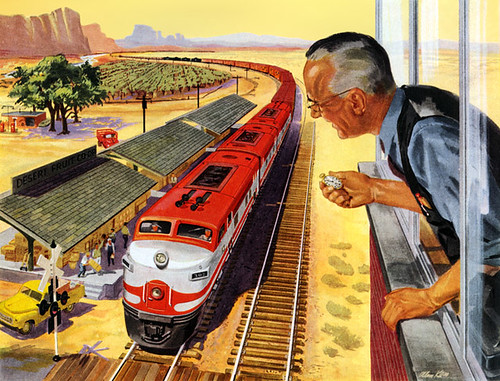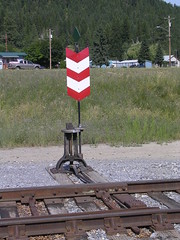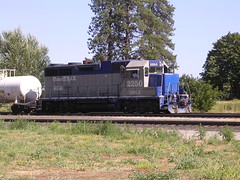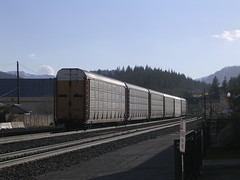Well, at least their switchstands still do. Photo taken at the Ione, WA depot.
This is the terminal for the Pend O'Reille Valley's excursion trains.
Views on Railroads, Railroad History, and Model Railroading in the West.
Friday, August 04, 2006
Wednesday, August 02, 2006
KFI Gets It Done
An OmniTrax Geep switches the yard in Kettle Falls, Washington on a very hot July 21, 2006.
Mind the Cobwebs
Sorry to have been gone so long!
There's some great stuff to cover! A trip to Reno and a trip to Northeast Washington, plus more trackplan ideas and my own evolving concepts.
Coming soon...
There's some great stuff to cover! A trip to Reno and a trip to Northeast Washington, plus more trackplan ideas and my own evolving concepts.
Coming soon...
Friday, April 14, 2006
Nightmare At Custer Creek
The Billings Gazette remembered the worst train wreck in Montana's history this week.
On the night of June 19, 1938, the Milwaukee Road's crack Olympian (its first-class Chicago-Seattle/Tacoma passenger train) was running westward through eastern Montana, along the Yellowstone River. Unbeknownst to anyone on the railroad, a thunderstorm unleashed a flash flood down Custer Creek, a minor tributary the Milwaukee crossed.
The flash flood came fast and sudden, washing out the foundations of the bridge which had been inspected not a half-hour before. The train started crossing the bridge, causing its collapse; the momentum of the locomotive carried it to the other bank, but it also dragged two sleeper cars into the flood-swollen creek.
Before the waters receded, they took 48 lives. For a railroad that had prided itself on a great safety record, especially where passengers were involved, the tragedy was unthinkable.
If you wanted to visit the site today, you could, but there won't be much to see. The bridge was rebuilt, and the name of the place changed. The Milwaukee Road doesn't even exist anymore; it retreated from the west in 1980.
On the night of June 19, 1938, the Milwaukee Road's crack Olympian (its first-class Chicago-Seattle/Tacoma passenger train) was running westward through eastern Montana, along the Yellowstone River. Unbeknownst to anyone on the railroad, a thunderstorm unleashed a flash flood down Custer Creek, a minor tributary the Milwaukee crossed.
The flash flood came fast and sudden, washing out the foundations of the bridge which had been inspected not a half-hour before. The train started crossing the bridge, causing its collapse; the momentum of the locomotive carried it to the other bank, but it also dragged two sleeper cars into the flood-swollen creek.
Before the waters receded, they took 48 lives. For a railroad that had prided itself on a great safety record, especially where passengers were involved, the tragedy was unthinkable.
If you wanted to visit the site today, you could, but there won't be much to see. The bridge was rebuilt, and the name of the place changed. The Milwaukee Road doesn't even exist anymore; it retreated from the west in 1980.
Friday, April 07, 2006
Racetrack
From Trains.com Newswire: (emphasis added by yours truly)
BNSF shows off the Transcon for press representativesLet me break that down for you: doubletrack = speed. This is a big deal. BNSF is putting a lot of money into this - and creating the premier route from the West Coast to Chicago in the process. The old Santa Fe is really moving now.
ALBUQUERQUE — To provide print media representatives a glimpse into its double-tracking efforts on the Chicago-Los Angeles “Transcon” main line between Kansas City and Albuquerque, BNSF Railway last Thursday operated, for invited press guests, a six-car passenger special with “theater” (tiered seats, full rear window) observation car Glacier View” on the rear.
Matt Rose, BNSF chairman, president, and CEO, led and narrated the tour, which focused on construction projects near Wellington, Kans.; Vaughn, N.Mex.; and Abo Canyon, a difficult stretch of New Mexico track on a 1.25 percent eastbound grade, where double-tracking efforts are complicated by the area’s rugged terrain and a waterway.
The railway has finished double-tracking about 97 percent of the entire Chicago-L.A. route for its ever-growing container trade from the Far East, BNSF officials said. In the next two years, the final single-track “bottleneck” gaps will be eliminated, boosting the line’s capacity from 80 to 120 trains each day. Work at Abo Canyon is expected to begin later this year, once all final permits are in place.
The need for the expansion was apparent at Fort Sumner, N.Mex., where the special passed two westbounds and four eastbounds waiting to negotiate one of the last stretches of single track.
Even as Rose spoke on the trip, BNSF was being designated as one of the top performers last year on the Standard & Poor's 500 stock index, according to a story in the Fort Worth Star-Telegram. But Rose knows that success can be just as treacherous as adversity, although the railroad now is having to deal with its success. Last year, BNSF enjoyed a record profit of $1.5 billion, not to mention a stock price that has climbed from the mid-$40 range last summer to more than $80. In the past two years, BNSF has increased its traffic volumes by 1.5 million carloads.
"Frankly, our service isn't what we want it to be," he said aboard the train. He noted that the railroad's on-time average had fallen in recent months from above 90 percent to around 80 percent. Systemwide average train speeds had dipped below 20 mph, indicating that traffic on BNSF's 32,000-mile system has slowed. In the old days, such cost-generating slowdowns were the product of deferred maintenance by cash-starved railroads. Today, for the first time in the memory of even the oldest railroaders, the nation's carriers have too much business.
"This is a world-class problem to have, but one that we must deal with," Rose said.
"That big intermodal business is the key to BNSF," says Darius Gaskins, the former chairman of the old Interstate Commerce Commission who was president of the Burlington Northern before it merged with Santa Fe in 1995. "BNSF has taken advantage of a terrific franchise. They don't have to depend on coal and grain as they did in the past."
Rose has told BNSF's 40,000 employees — a number that has increased by about 11,000 in the past three years and is expected to go up 3,500 this year — that "velocity" will be the watchword for BNSF this year.
"This is a volume business," Rose said as the train sped over newly laid concrete ties. "The better the system is moving, the more volume we can handle. It's as simple as that. Our biggest problem has been understanding market growth, which has been greater than anticipated. You couldn't get anybody to believe that traffic could rise by 10 [to] 15 percent annually, but that's what happened beginning in 2003."
Rose is the first to admit that customers are less than thrilled with slowdowns in service, combined with higher prices. The most influential shipper group, the National Industrial Transportation League, said in a report that "many of the changes [since deregulation] have resulted in greater market power for the railroad industry and decreased competitive options for shippers."
Rose said that "in a typical year, more than 200 businesses make a conscious decision to locate on our lines and use our shipping. I'm not going to apologize for what the industry has done," he says. "Unlike the highways and the airports, our track and yard systems are privately owned. We pay for all of our improvements."
— Jim Wrinn
Friday, March 31, 2006
Billings, MT Was - And Is - A Railroad Town
I had the opportunity to travel up to Billings this week. And it fired up the imagination.
Billings is one of Montana's largest cities - but that is a matter of comparison. As cities go, it is on the small side, wedged between the rimrock cliffs carved by the Yellowstone River.
But to the modeller, Billings is a fantastic little city. It features two modern railroads, Montana Rail Link and BNSF. It has a rich and fairly well-preserved Northern Pacific heritage, and traces of MRL and predecessor BN are to be found all over.
The local industry mix is fantastic. Montana's economy is still resource based, and the mix of industry reflects that. There are three major oil refineries within twenty miles of Billings, including one on the south side of Billings proper. Just west of the refinery is a large but manageable coal-fired power plant - one easily modelled by the Walthers Tri-State Authority model recently retired. This plant receives unit trains of (I'm assuming) Powder River coal, in Montana Power-owned coal cars.
And that doesn't include the grain elevators and sugar refinery on the southwest edge of town.
Track-planners, it's worth a look... (Pictures to follow.)
Billings is one of Montana's largest cities - but that is a matter of comparison. As cities go, it is on the small side, wedged between the rimrock cliffs carved by the Yellowstone River.
But to the modeller, Billings is a fantastic little city. It features two modern railroads, Montana Rail Link and BNSF. It has a rich and fairly well-preserved Northern Pacific heritage, and traces of MRL and predecessor BN are to be found all over.
The local industry mix is fantastic. Montana's economy is still resource based, and the mix of industry reflects that. There are three major oil refineries within twenty miles of Billings, including one on the south side of Billings proper. Just west of the refinery is a large but manageable coal-fired power plant - one easily modelled by the Walthers Tri-State Authority model recently retired. This plant receives unit trains of (I'm assuming) Powder River coal, in Montana Power-owned coal cars.
And that doesn't include the grain elevators and sugar refinery on the southwest edge of town.
Track-planners, it's worth a look... (Pictures to follow.)
Friday, March 10, 2006
The P&W as a Model Railroad
Just a thought - check out the Providence & Worchester if you need some model railroad ideas...
Yes, I'm already thinking about it.
Yes, I'm already thinking about it.
Monday, January 30, 2006
Rough Weekend For The Empire Builder
From the Seattle Times:
First, this was only the Portland-Spokane section of the Empire Builder. It combines with the larger Seattle-Spokane-Chicago section at Spokane, and continues east as one train. That is why the train is so small - one locomotive and four cars. The combined Builder is probably three locomotives and 8-10 cars.
I don't know what track BNSF is planning to detour on. The only ways to detour trains is either go all the way up to Seattle and over a very congested Stevens Pass, or detour on the Union Pacific line between Pasco, WA, and Spokane. My guess is probably detour a couple of high-priority trains on the latter. Incidentally, the old BN used to have a well-engineered second line between Pasco and Spokane - and abandoned it in 1987.
Rough weekend up in Washington State. And lloks like it will be a while before it gets better - according to this Seattle Times article, BNSF maintenance-of-way crews have had their hands full, with multiple slides between Seattle and Everett and between Tacoma and Chehalis, as well as the Empire Builder derailment.
Chicago-bound Amtrak train derails near SpokaneA couple of notes:
By The Associated Press
SPOKANE, Wash. — A Chicago-bound Amtrak passenger train derailed early Saturday near Spokane, but there were no serious injuries.
Minor injuries to a few of the 86 passengers and six crew members on the eastbound Empire Builder were treated at the high school gymn in the town of Sprague, near the accident site about 45 miles west of Spokane, said Amtrak spokeswoman Tracy Connell.
Passengers were then bused to hotels in Spokane, where they will hope to resume their journey on Saturday night's Empire Builder, which travels between Chicago and Portland, Ore. There is one westbound and one eastbound train on the route daily.
The derailed train's engine and four cars remained upright after leaving the track, and equipment was brought in before dawn from Spokane and Pasco to rerail them, said Seattle spokesman Gus Melonas for Burlington Northern Santa Fe, which owns and maintains the tracks.
Fort Worth, Texas-based BNSF expected to have the damaged single main-line track reopened within 24 hours, he said. In the meantime, some freight traffic will be detoured on alternate lines within the state.
Amtrak passengers will be bused between Spokane and Portland, Ore., during the interruption, Melonas said.
The cause of the derailment was under investigation, he said.
Copyright © 2006 The Seattle Times Company
First, this was only the Portland-Spokane section of the Empire Builder. It combines with the larger Seattle-Spokane-Chicago section at Spokane, and continues east as one train. That is why the train is so small - one locomotive and four cars. The combined Builder is probably three locomotives and 8-10 cars.
I don't know what track BNSF is planning to detour on. The only ways to detour trains is either go all the way up to Seattle and over a very congested Stevens Pass, or detour on the Union Pacific line between Pasco, WA, and Spokane. My guess is probably detour a couple of high-priority trains on the latter. Incidentally, the old BN used to have a well-engineered second line between Pasco and Spokane - and abandoned it in 1987.
Rough weekend up in Washington State. And lloks like it will be a while before it gets better - according to this Seattle Times article, BNSF maintenance-of-way crews have had their hands full, with multiple slides between Seattle and Everett and between Tacoma and Chehalis, as well as the Empire Builder derailment.
Thursday, January 19, 2006
SPR: Lurching South
Scratch-Pad Ramblings:
Lurching South - The Saga of the Nevada Western
I warned you watching train videos and reading train books can be a bad idea.

Yet another train layout concept has been born; a line running from Nowhere, Nevada, to Where-in-the-heck-are-we, California.
Actually, there would be a point to this line; and, it would be connecting actual towns. I actually wouldn't be doing much grading of new line.
Ninety years ago, the railroad map of Nevada looked considerably different. (From Nevada Northern & the Railroads of White Pine County.) A plethora of exotic-sounding shortlines ran down the California-Nevada border, connecting Reno with Las Vegas: Virginia & Truckee ("Queen of the Shortlines"), Carson & Colorado, Tonopah & Goldield, Bullfrog & Goldfield, Las Vegas & Tonopah, Tonopah & Tidewater...
But connecting Nevada's two biggest cities is not the reason for their existence; at the time they were built, Las Vegas was a tiny tank town on the Union Pacific. No, these roads were built to move minerals to market. The last great American gold rush occurred in the 1900's; and they railroads were laid to the gold camps as fast as they could find the rails.
Most of the roads disappeared during or immediately after World War Two; FDR's ban on precious metal mining had destroyed the weak economies of the surviving mining towns. The V&T managed to hang on until 1950, until it, too, was scrapped.
But this free-lancing stuff is great for grim situations like this.
By a fortunate coincidence of history, the lines survived well into the late twentieth century. The oil wells near Tonopah proved more prolific than expected, and the mineral wealth of the high desert continued to fill the pockets of high desert industrialists. And explorations into the Eastern Sierra brought more - more opportunities (lumber), more traffic (more oil & minerals), and more business. And as Las Vegas grew, so did traffic from the north.
With the growth of Las Vegas into a booming business city as well as a resort destination (thanks to a business-friendly tax regime), the Western Pacific saw an opportunity for a piece of the action.
This is obviously just a developing concept, and needs a lot of work yet. But what do you think so far?
For inspiration and more information:
Nevada State Railroad Museum
Virginia & Truckee Railroad
Nevada Northern & the Railroads of White Pine County
Tonopah & Tidewater - A Study
Great Basin Research
Gordon Osmundson Photographs
Back to Scratch-Pad Ramblings.
Lurching South - The Saga of the Nevada Western
I warned you watching train videos and reading train books can be a bad idea.

Yet another train layout concept has been born; a line running from Nowhere, Nevada, to Where-in-the-heck-are-we, California.
Actually, there would be a point to this line; and, it would be connecting actual towns. I actually wouldn't be doing much grading of new line.
Ninety years ago, the railroad map of Nevada looked considerably different. (From Nevada Northern & the Railroads of White Pine County.) A plethora of exotic-sounding shortlines ran down the California-Nevada border, connecting Reno with Las Vegas: Virginia & Truckee ("Queen of the Shortlines"), Carson & Colorado, Tonopah & Goldield, Bullfrog & Goldfield, Las Vegas & Tonopah, Tonopah & Tidewater...
But connecting Nevada's two biggest cities is not the reason for their existence; at the time they were built, Las Vegas was a tiny tank town on the Union Pacific. No, these roads were built to move minerals to market. The last great American gold rush occurred in the 1900's; and they railroads were laid to the gold camps as fast as they could find the rails.
Most of the roads disappeared during or immediately after World War Two; FDR's ban on precious metal mining had destroyed the weak economies of the surviving mining towns. The V&T managed to hang on until 1950, until it, too, was scrapped.
But this free-lancing stuff is great for grim situations like this.
By a fortunate coincidence of history, the lines survived well into the late twentieth century. The oil wells near Tonopah proved more prolific than expected, and the mineral wealth of the high desert continued to fill the pockets of high desert industrialists. And explorations into the Eastern Sierra brought more - more opportunities (lumber), more traffic (more oil & minerals), and more business. And as Las Vegas grew, so did traffic from the north.
With the growth of Las Vegas into a booming business city as well as a resort destination (thanks to a business-friendly tax regime), the Western Pacific saw an opportunity for a piece of the action.
This is obviously just a developing concept, and needs a lot of work yet. But what do you think so far?
For inspiration and more information:
Nevada State Railroad Museum
Virginia & Truckee Railroad
Nevada Northern & the Railroads of White Pine County
Tonopah & Tidewater - A Study
Great Basin Research
Gordon Osmundson Photographs
Back to Scratch-Pad Ramblings.
Subscribe to:
Posts (Atom)


